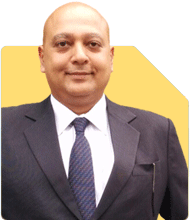Ramalingam Kalirajan |9865 Answers |Ask -Follow
Mutual Funds, Financial Planning Expert - Answered on Jun 07, 2024
He has an MBA in finance from the University of Madras and is a certified financial planner.
He is the director and chief financial planner at Holistic Investment, a Chennai-based firm that offers financial planning and wealth management advice.... more

Hello Sir, I am 34 years old. Married. As of now we don't have any child. Now below is my asset. 1) Salary 90 k average. 2) post office scheme (1.6 crore as of now) 3) 17 lakh and it's growing.maturity 2031. 5) share plus mutual Fund almost 20 lakh 6) own a house. Want to take off from work at the age of 40. What should be my planning so that it goes smooth after that. Job is not secure one point to be noted.
Understanding Your Financial Situation
At 34, you have a strong financial foundation. Your average salary is Rs 90,000 per month. You have a significant amount invested in a post office scheme, totaling Rs 1.6 crore. Additionally, you have Rs 17 lakh growing with maturity in 2031, and Rs 20 lakh in shares and mutual funds. Owning a house adds to your financial stability. However, you are concerned about job security and want to take a break from work at 40.
Evaluating Early Retirement Viability
Retiring at 40 is an ambitious goal. It requires careful planning and significant savings. Given the current financial landscape and potential uncertainties, early retirement may not be viable. Instead, consider upskilling to increase your employability. This can provide financial security and flexibility.
Upskilling for Financial Security
Upskilling can enhance your career prospects. Invest in courses and certifications relevant to your field. This can help you secure a higher-paying job or transition to a more stable industry. Continuously updating your skills can also make you more competitive in the job market.
Enhancing Your Employability
Consider pursuing advanced degrees or professional certifications. Networking with industry professionals can provide job leads and career advice. Stay informed about industry trends and developments. This can help you identify opportunities and make informed career decisions.
Diversifying Your Investments
Your investments are currently diversified, but there is room for optimization. The post office scheme is a safe investment but may not offer high returns. Consider reallocating a portion of these funds to mutual funds for potentially higher returns. Actively managed mutual funds can outperform the market and offer better growth prospects.
Advantages of Actively Managed Funds
Actively managed funds have professional fund managers who make strategic investment decisions. They aim to outperform market benchmarks. These funds can offer higher returns compared to passive index funds. This can be beneficial for long-term growth and wealth accumulation.
Investment in Mutual Funds
Mutual funds can provide diversified exposure to various asset classes. Consider investing in equity, debt, and hybrid funds. This can balance risk and return, and provide stable growth over time. Regularly review your mutual fund portfolio and make adjustments as needed.
Long-Term Investment Planning
Investing for the long term can provide significant growth. Compounding can enhance your wealth over time. Set long-term financial goals and create an investment plan to achieve them. Regularly contribute to your investment portfolio to build wealth consistently.
Importance of Emergency Fund
Maintain an emergency fund to cover unexpected expenses. This fund should cover at least six months of living expenses. It provides financial security and peace of mind. An emergency fund is crucial, especially considering your job security concerns.
Creating a Retirement Corpus
Calculate the amount needed for retirement. Consider your current lifestyle, future expenses, and inflation. Create a retirement corpus that can sustain your desired lifestyle. Factor in healthcare costs, travel, and leisure activities.
Regular Savings and Investments
Consistently save and invest a portion of your income. Automate your savings to ensure regular contributions. This can help you build a substantial retirement corpus over time. Regular investments can benefit from rupee cost averaging, reducing the impact of market volatility.
Tax Planning
Effective tax planning can optimize your savings. Utilize tax-saving instruments and strategies to reduce your tax liability. This can increase your post-tax returns and enhance your overall savings. Consult with a Certified Financial Planner (CFP) for personalized tax planning advice.
Reviewing Your Financial Plan
Regularly review and update your financial plan. Life circumstances and financial markets change. Adjustments may be necessary to stay on track. A CFP can help you navigate these changes and ensure your plan remains aligned with your goals.
Healthcare and Insurance
Ensure you have adequate health insurance coverage. Healthcare costs can rise significantly with age. Health insurance can protect your savings from medical expenses. Consider additional insurance for critical illnesses and long-term care.
Estate Planning
Plan for the distribution of your assets. Create a will and consider setting up a trust. This ensures your assets are distributed according to your wishes. It also helps in minimizing potential legal complications for your heirs.
Debt Management
Manage and reduce your debts before considering early retirement. High-interest debts can erode your savings. Aim to be debt-free or have manageable debt levels. This can provide financial stability and reduce stress.
Sustainable Withdrawal Rate
Determine a sustainable withdrawal rate from your savings. Financial planners often recommend a 4% withdrawal rate. This means withdrawing 4% of your retirement savings annually. This helps ensure your funds last throughout retirement.
Inflation and Its Impact
Inflation erodes purchasing power over time. Consider investments that offer returns above inflation. This helps maintain the value of your savings. Regularly review and adjust your investments to stay ahead of inflation.
Creating a Retirement Budget
Develop a detailed retirement budget. Include all potential expenses. This helps in understanding your financial needs. Adjust your budget periodically to reflect changes in your lifestyle or unexpected expenses.
Retirement Lifestyle Planning
Consider how you want to spend your retirement. Factor in hobbies, travel, and leisure activities. This helps in estimating lifestyle-related expenses. Planning for a fulfilling retirement lifestyle is as important as financial planning.
Professional Advice
Seek advice from a CFP. They provide personalized financial planning. A CFP can help you navigate complex financial decisions and ensure your retirement plan is on track. Professional guidance can enhance your financial security and peace of mind.
Final Insights
Early retirement at 40 requires significant financial planning and savings. Given the current financial landscape, it may not be viable. Instead, focus on upskilling to increase employability and secure a stable income. Diversify your investments to optimize returns. Regularly review your financial plan and make necessary adjustments. Seek professional advice from a CFP for personalized guidance. With careful planning and strategic investments, you can achieve financial security and a comfortable retirement.
Best Regards,
K. Ramalingam, MBA, CFP,
Chief Financial Planner,
www.holisticinvestment.in
You may like to see similar questions and answers below
Ramalingam Kalirajan |9865 Answers |Ask -Follow
Mutual Funds, Financial Planning Expert - Answered on May 24, 2024
Ramalingam Kalirajan |9865 Answers |Ask -Follow
Mutual Funds, Financial Planning Expert - Answered on Sep 28, 2024
Radheshyam Zanwar |5907 Answers |Ask -Follow
MHT-CET, IIT-JEE, NEET-UG Expert - Answered on Jul 28, 2025
Ramalingam Kalirajan |9865 Answers |Ask -Follow
Mutual Funds, Financial Planning Expert - Answered on Jul 28, 2025
Radheshyam Zanwar |5907 Answers |Ask -Follow
MHT-CET, IIT-JEE, NEET-UG Expert - Answered on Jul 28, 2025
Radheshyam Zanwar |5907 Answers |Ask -Follow
MHT-CET, IIT-JEE, NEET-UG Expert - Answered on Jul 28, 2025
Radheshyam Zanwar |5907 Answers |Ask -Follow
MHT-CET, IIT-JEE, NEET-UG Expert - Answered on Jul 28, 2025
Nayagam P P |9561 Answers |Ask -Follow
Career Counsellor - Answered on Jul 28, 2025
Radheshyam Zanwar |5907 Answers |Ask -Follow
MHT-CET, IIT-JEE, NEET-UG Expert - Answered on Jul 28, 2025
Radheshyam Zanwar |5907 Answers |Ask -Follow
MHT-CET, IIT-JEE, NEET-UG Expert - Answered on Jul 28, 2025
Sushil Sukhwani |617 Answers |Ask -Follow
Study Abroad Expert - Answered on Jul 28, 2025
Radheshyam Zanwar |5907 Answers |Ask -Follow
MHT-CET, IIT-JEE, NEET-UG Expert - Answered on Jul 28, 2025


















